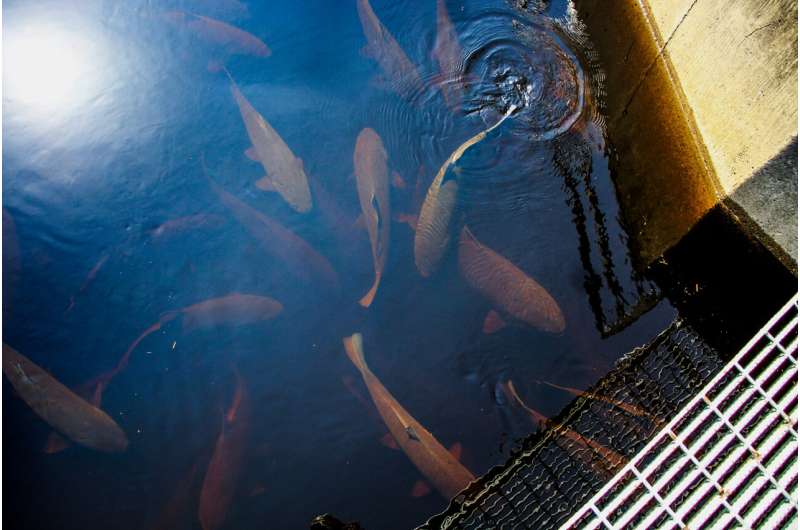
Bigmouth buffalo migration in an around Rice Lake National Wildlife Refuge. Credit: Alec Lackmann
A recent study in one of the most pristine spawning grounds for a Minnesota fish has found a half-century gap between successful broods, and that number’s climbing.
That’s according to new research on the bigmouth buffalo (Ictiobus cyprinellus) from the University of Minnesota Duluth (UMD), recently published in Scientific Reports.
The study was led by Alec Lackmann, Ph.D., an ichthyologist and assistant professor of Mathematics and Statistics, and Mark Clark, Ph.D., a professor of Biology, both from the Swenson College of Science and Engineering at UMD.
The bigmouth buffalo is a fish that’s native to Minnesota and known for its longevity. Researchers wanted to find out more about the species, especially how they migrate, spawn, and how often their offspring live into adulthood. For three years, from 2021 through 2023, Lackmann and his team studied the recreational exploitation (bowfishing, spearfishing, hook-and-line angling) of the species, and analyzed the bigmouth buffalo migration in and around Rice Lake National Wildlife Refuge, near McGregor, Minnesota.
Results of the study include:
Discovery of one of the oldest known populations of vertebrate (median age of 79 years as of 2024)
A more than 60-year generation gap since the last major recruitment event occurred in this population, again exposing the stark vulnerability of bigmouth buffalo in Minnesota.
Confirmation that fish are successfully migrating and breeding, but the young are not surviving, likely due to the predator gauntlet they face on their way to adulthood.
Highlights the unique management challenges of bigmouth buffalo, including highly variable spawning durations year to year, and the need to protect adults as they grow and invest disproportionately more into reproduction.
Lackmann and Clark have studied buffalofishes before, and their research from 2019 went so far as to extend the previously thought maximum age of bigmouth buffalo from around 25 years of age, to more than 100 years of age through improved aging techniques. The team’s subsequent bigmouth buffalo studies in North Dakota (2021) and Canada (2023) documented environmental conditions related to their sporadic recruitment success, and his team’s 2023 study published in Scientific Reports found the second genus of animal ever for which three or more species (buffalofishes) have known lifespans greater than 100 years.
“No one’s really looked at the spawning phenology of bigmouth buffalo before,” said Lackmann.
Over the course of the Rice Lake study, he and his team examined nearly 400 adult fish, taking measurements of each fish’s length and weight, whether it had spawned, its physical features, and age. Researchers were able to conclude that water control measures established in 1953 were correlated with a reduced likelihood of later generations, and of the 390 fish studied, only one was from a hatch-year after 1971. The study also revealed bigmouth buffalo were successfully reproducing, but by mid‐to‐late summer, the young were conspicuously absent, having likely succumbed to predation by northern pike and other predators.
“We have found that more than 95% of the current population hatched prior to the 1960s,” said Lackmann. With that much of a gap, it’s surprising that the buffalofish have survived for generations. But, according to Lackmann, it speaks to the amazing attributes of these fish. “This species evolved to have a long lifespan for an adaptive reason: to bridge these long gaps that can naturally occur.”
During the 1970s, the bigmouth buffalo was recorded as declining in Canada, Minnesota, and North Dakota and became a protected species in Canada. In the U.S., population declines are exacerbated by wasteful recreational bowfishing, lack of fisheries management, and overall lack of knowledge.
For Lackmann, this study further underscores the importance of implementing basic principles of fisheries management to protect bigmouth buffalo and other native species. Lackmann acknowledges that steps are currently underway to protect native fishes in the state of Minnesota, such as the “No Junk Fish Bill” that became law this spring, but he says there remains much work to be done in practice. For example, unlimited exploitation across the entire year remains open on bigmouth buffalo throughout Minnesota as of September 2024.
“There is 50-year recruitment failure for bigmouth buffalo in this system, even though we know that they’re migrating and spawning annually. This is something that’s completely unparalleled in the animal kingdom, as far as we know, for a species to be going so long without successfully having another generation,” said Lackmann. “When you couple that with the current, unlimited and unregulated nature of their exploitation that’s been increasing, especially in the past 10 years with the rise of bowfishing, there is extreme concern for the long-term sustainability of this species.”
In addition to Lackmann and Clark from the University of Minnesota Duluth, the study was in collaboration with the Aitkin County Soil and Water Conservation District, the United States Fish and Wildlife Service, and North Dakota State University.
More information:
Alec R. Lackmann et al, Analysis of bigmouth buffalo Ictiobus cyprinellus spawning phenology in Minnesota reveals 50-year recruitment failure and conservation concern, Scientific Reports (2024). DOI: 10.1038/s41598-024-70237-5
Provided by
University of Minnesota
Citation:
Research shows 50-year generation gap in the bigmouth buffalo, Minnesota’s longest-lived fish (2024, September 3)
retrieved 3 September 2024
from
This document is subject to copyright. Apart from any fair dealing for the purpose of private study or research, no
part may be reproduced without the written permission. The content is provided for information purposes only.
Source link : http://www.bing.com/news/apiclick.aspx?ref=FexRss&aid=&tid=66d76853a76b47ef8d0f1eff5e5fc139&url=https%3A%2F%2Fphys.org%2Fnews%2F2024-09-year-generation-gap-bigmouth-buffalo.html&c=531152256514388562&mkt=en-us
Author :
Publish date : 2024-09-03 08:29:00
Copyright for syndicated content belongs to the linked Source.





